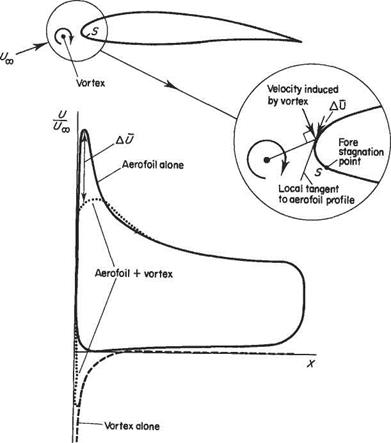The slat effect
To appreciate qualitatively the effect of the upstream element (e. g. the slat) on the immediate downstream element (e. g. the main aerofoil) the former can be modelled by a vortex. The effect is illustrated in Fig. 8.11. When one considers the component of the velocity induced by the vortex in the direction of the local tangent to the aerofoil contour in the vicinity of the leading edge (see inset in Fig. 8.11), it can be seen that the slat (vortex) acts to reduce the velocity along the edge of the boundary layer on the upper surface and has the opposite effect on the lower surface. Thus the effect of the slat is to reduce the severity of the adverse pressure gradient on the main aerofoil. In the case illustrated schematically in Fig. 8.11 it can be seen that the consequent reduction in pressure over the upper surface is counter-balanced by the rise in pressure on the lower surface. For a well-designed slat/main-wing combination it can be arranged that the latter effect predominates resulting in a slight rise in lift coefficient.
|
Fig. 8.11 Effect of a slat (modelled by a vortex) on the velocity distribution over the main aerofoil |
8.3.2 The vane effect
In a similar way the effect of the downstream element (e. g. the vane) on the immediate upstream element (e. g. the main aerofoil) can also be modelled approximately by placing a vortex near the trailing edge of the latter. This effect is illustrated in Fig. 8.12. This time the vane (vortex) near the trailing edge induces a velocity over the main aerofoil surface that leads to a rise in velocity on both upper and lower surfaces. In the case of the upper surface this is beneficial because it raises the velocity at the trailing edge, thereby reducing the severity of the adverse pressure gradient. In addition to this, the vane has a second beneficial effect. This can be understood from the inset in Fig. 8.12. Note that owing to the velocity induced by the vane at the trailing edge, the effective angle of attack has been increased. If matters were left unchanged the streamline would not now leave smoothly from the trailing edge of the main aerofoil. This would violate the Kutta condition – see Section 4.1.1. What must happen is that viscous effects generate additional circulation in order that the Kutta condition be satisfied once again. Thus the presence of the vane leads to enhanced circulation and, therefore, higher lift.












